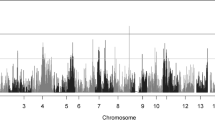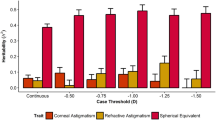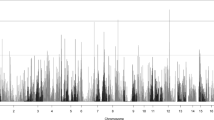Abstract
The development of refractive error is mediated by both environmental and genetic factors. We performed regression-based quantitative trait locus (QTL) linkage analysis on Ashkenazi Jewish families to identify regions in the genome responsible for ocular refraction. We measured refractive error on individuals in 49 multi-generational American families of Ashkenazi Jewish descent. The average family size was 11.1 individuals and was composed of 2.7 generations. Recruitment criteria specified that each family contain at least two myopic members. The mean spherical equivalent refractive error in the sample was −3.46D (SD=3.29) and 87% of individuals were myopic. Microsatellite genotyping with 387 markers was performed on 411 individuals. We performed multipoint regression-based linkage analysis for ocular refraction and a log transformation of the trait using the statistical package Merlin-Regress. Empirical genomewide significance levels were estimated through gene-dropping simulations by generating random genotypes at each of the 387 markers in 200 replicates of our pedigrees. Maximum LOD scores of 9.5 for ocular refraction and 8.7 for log-transformed refraction (LTR) were observed at 49.1 cM on chromosome 1p36 between markers D1S552 and D1S1622. The empirical genomewide significance levels were P=0.065 for ocular refraction and P<0.005 for LTR, providing strong evidence for linkage of refraction to this locus. The inter-marker region containing the peak spans 11 Mb and contains approximately 189 genes. Conclusion: We found genomewide significant evidence for linkage of refractive error to a novel QTL on chromosome 1p36 in an Ashkenazi Jewish population.


Similar content being viewed by others
References
Abecasis GR, Cherny SS, Cookson WO, Cardon LR (2002) Merlin–rapid analysis of dense genetic maps using sparse gene flow trees. Nat Genet 30(1):97–101
Alsbirk PH (1979) Refraction in adult West Greenland Eskimos. A population study of spherical refractive errors, including oculometric and familial correlations. Acta Ophthalmol (Copenh) 57(1):84–95
Attebo K, Ivers RQ, Mitchell P (1999) Refractive errors in an older population: the Blue Mountains Eye Study. Ophthalmology 106(6):1066–1072
Au Eong KG, Tay TH, Lim MK (1993) Race, culture and Myopia in 110,236 young Singaporean males. Singapore Med J 34(1):29–32
Bear JC, Richler A, Burke G (1981) Nearwork and familial resemblances in ocular refraction: a population study in Newfoundland. Clin Genet 19(6):462–472
Ben Simon GJ, Peiss M, Anis E, Nakra T, Luski A, Spierer A (2004) Spectacle use and reduced unaided vision in third grade students: a comparative study in different educational settings. Clin Exp Optom 87(3):175–179
Biino G, Palmas MA, Corona C, Prodi D, Fanciulli M, Sulis R, Serra A, Fossarello M, Pirastu M (2005) Ocular refraction: heritability and genome-wide search for eye morphometry traits in an isolated Sardinian population. Hum Genet 116(3):152–159
Boehnke M, Cox NJ (1997) Accurate inference of relationships in sib-pair linkage studies. Am J Hum Genet 61(2):423–429
Broman KW, Weber JL (1998) Estimation of pairwise relationships in the presence of genotyping errors. Am J Hum Genet 63(5):1563–1564
Cohen SY, Laroche A, Leguen Y, Soubrane G, Coscas GJ (1996) Etiology of choroidal neovascularization in young patients. Ophthalmology 103(8):1241–1244
Dominguez M, Ferres-Marco D, Gutierrez-Avino FJ, Speicher SA, Beneyto M (2004) Growth and specification of the eye are controlled independently by Eyegone and Eyeless in Drosophila melanogaster. Nat Genet 36(1):31–39
Duffy DL (1997) Sibpair: a program for nonparametric linkage/association analysis. Am J Hum Genet 61(Suppl):A197
Durner M, Greenberg DA, Hodge SE (1992) Inter- and intrafamilial heterogeneity: effective sampling strategies and comparison of analysis methods. Am J Hum Genet 51(4):859–870
Fan DS, Lam DS, Lam RF, Lau JT, Chong KS, Cheung EY, Lai RY, Chew SJ (2004) Prevalence, incidence, and progression of myopia of school children in Hong Kong. Invest Ophthalmol Vis Sci 45(4):1071–1075
Farbrother JE, Kirov G, Owen MJ, Pong-Wong R, Haley CS, Guggenheim JA (2004) Linkage analysis of the genetic loci for high myopia on 18p, 12q, and 17q in 51 U.K. families. Invest Ophthalmol Vis Sci 45(9):2879–2885
Hammond CJ, Andrew T, Tat MY, Spector TD (2004) A susceptibility locus for myopia in the normal population is linked to the PAX6 gene region on chromosome 11: a genomewide scan of dizygotic twins. Am J Hum Genet 75(2):294–304
Hammond CJ, Snieder H, Gilbert CE, Spector TD (2001) Genes and environment in refractive error: the twin eye study. Invest Ophthalmol Vis Sci 42(6):1232–1236
Hanson I, Churchill A, Love J, Axton R, Moore T, Clarke M, Meire F, van Heyningen V (1999) Missense mutations in the most ancient residues of the PAX6 paired domain underlie a spectrum of human congenital eye malformations. Hum Mol Genet 8(2):165–172
He M, Zeng J, Liu Y, Xu J, Pokharel GP, Ellwein LB (2004) Refractive error and visual impairment in urban children in southern china. Invest Ophthalmol Vis Sci 45(3):793–799
Ibay G, Doan B, Reider L, Dana D, Schlifka M, Hu H, Holmes T, O’Neill J, Owens R, Ciner E, Bailey-Wilson JE, Stambolian D (2004) Candidate high myopia loci on chromosomes 18p and 12q do not play a major role in susceptibility to common myopia. BMC Med Genet 5(1):20
Lander E, Kruglyak L (1995) Genetic dissection of complex traits: guidelines for interpreting and reporting linkage results. Nat Genet 11(3):241–247
Lander ES, Green P (1987) Construction of multilocus genetic linkage maps in humans. Proc Natl Acad Sci USA 84(8):2363–2367
Lee KE, Klein BE, Klein R, Fine JP (2001) Aggregation of refractive error and 5-year changes in refractive error among families in the Beaver Dam Eye Study. Arch Ophthalmol 119(11):1679–1685
Leske MC, Wu SY, Nemesure B, Hennis A (2002) Risk factors for incident nuclear opacities. Ophthalmology 109(7):1303–1308
Lim R, Mitchell P, Cumming RG (1999) Refractive associations with cataract: the Blue Mountains Eye Study. Invest Ophthalmol Vis Sci 40(12):3021–3026
Lin LL, Shih YF, Tsai CB, Chen CJ, Lee LA, Hung PT, Hou PK (1999) Epidemiologic study of ocular refraction among schoolchildren in Taiwan in 1995. Optom Vis Sci 76(5):275–281
Lyhne N, Sjolie AK, Kyvik KO, Green A (2001) The importance of genes and environment for ocular refraction and its determiners: a population based study among 20–45 year old twins. Br J Ophthalmol 85(12):1470–1476
Matsumura H, Hirai H (1999) Prevalence of myopia and refractive changes in students from 3 to 17 years of age. Surv Ophthalmol 44(Suppl 1):S109–S115
Mitchell P, Hourihan F, Sandbach J, Wang JJ (1999) The relationship between glaucoma and myopia: the Blue Mountains Eye Study. Ophthalmology 106(10):2010–2015
Munoz B, West SK, Rubin GS, Schein OD, Quigley HA, Bressler SB, Bandeen-Roche K (2000) Causes of blindness and visual impairment in a population of older Americans: the Salisbury Eye Evaluation Study. Arch Ophthalmol 118(6):819–825
Naiglin L, Clayton J, Gazagne C, Dallongeville F, Malecaze F, Calvas P (1999) Familial high myopia: evidence of an autosomal dominant mode of inheritance and genetic heterogeneity. Ann Genet 42(3):140–146
Naiglin L, Gazagne C, Dallongeville F, Thalamas C, Idder A, Rascol O, Malecaze F, Calvas P (2002) A genome wide scan for familial high myopia suggests a novel locus on chromosome 7q36. J Med Genet 39(2):118–124
Paluru P, Ronan SM, Heon E, Devoto M, Wildenberg SC, Scavello G, Holleschau A, Makitie O, Cole WG, King RA, Young TL (2003) New locus for autosomal dominant high myopia maps to the long arm of chromosome 17. Invest Ophthalmol Vis Sci 44(5):1830–1836
Pierro L, Camesasca FI, Mischi M, Brancato R (1992) Peripheral retinal changes and axial myopia. Retina 12(1):12–17
Rosner M, Belkin M (1991) A nation-wide study of myopia prevalence in Israel. Findings in a population of 312,149 young adults. Metab Pediatr Syst Ophthalmol 14(2):37–41
Saw SM (2003) A synopsis of the prevalence rates and environmental risk factors for myopia. Clin Exp Optom 86(5):289–294
Saw SM, Hong RZ, Zhang MZ, Fu ZF, Ye M, Tan D, Chew SJ (2001) Near-work activity and myopia in rural and urban schoolchildren in China. J Pediatr Ophthalmol Strabismus 38(3):149–155
Schein OD, Poggio EC (1990) Ulcerative keratitis in contact lens wearers. Incidence and risk factors. Cornea 9(suppl 1):S55–S58
Sham PC, Purcell S, Cherny SS, Abecasis GR (2002) Powerful regression-based quantitative-trait linkage analysis of general pedigrees. Am J Hum Genet 71(2):238–253
Stambolian D, Ciner EB, Reider LC, Moy C, Dana D, Owens R, Schlifka M, Holmes T, Ibay G, Bailey-Wilson JE (2005) Genome-wide scan for myopia in the Old Order Amish. Am J Ophthalmol 140(3):469–476
Stambolian D, Ibay G, Reider L, Dana D, Moy C, Schlifka M, Holmes T, Ciner E, Bailey-Wilson JE (2004) Genomewide linkage scan for myopia susceptibility loci among Ashkenazi Jewish families shows evidence of linkage on chromosome 22q12. Am J Hum Genet 75(3):448–459
Stulting RD, Carr JD, Thompson KP, Waring GO III, Wiley WM, Walker JG (1999) Complications of laser in situ keratomileusis for the correction of myopia. Ophthalmology 106(1):13–20
Teikari JM, Kaprio J, Koskenvuo M, O’Donnell J (1992) Heritability of defects of far vision in young adults—a twin study. Scand J Soc Med 20(2):73–78
Teikari JM, O’Donnell J, Kaprio J, Koskenvuo M (1991) Impact of heredity in myopia. Hum Hered 41(3):151–156
Tielsch JM, Sommer A, Witt K, Katz J, Royall RM (1990) Blindness and visual impairment in an American urban population. The Baltimore Eye Survey. Arch Ophthalmol 108(2):286–290
VanNewkirk MR, Weih L, McCarty CA, Taylor HR (2001) Cause-specific prevalence of bilateral visual impairment in Victoria, Australia: the Visual Impairment Project. Ophthalmology 108(5):960–967
Vongphanit J, Mitchell P, Wang JJ (2002) Prevalence and progression of myopic retinopathy in an older population. Ophthalmology 109(4):704–711
Wawersik S, Maas RL (2000) Vertebrate eye development as modeled in Drosophila. Hum Mol Genet 9(6):917–925
Wojciechowski R, Congdon N, Bowie H, Munoz B, Gilbert D, West SK (2005) Heritability of refractive error and familial aggregation of myopia in an elderly American population. Invest Ophthalmol Vis Sci 46(5):1588–1592
Young A (1995) GAS (Genetic Analysis System) Version 2.0,Oxford, United Kingdom
Young TL, Deeb SS, Ronan SM, Dewan AT, Alvear AB, Scavello GS, Paluru PC, Brott MS, Hayashi T, Holleschau AM, Benegas N, Schwartz M, Atwood LD, Oetting WS, Rosenberg T, Motulsky AG, King RA (2004) X-linked high myopia associated with cone dysfunction. Arch Ophthalmol 122(6):897–908
Young TL, Ronan SM, Alvear AB, Wildenberg SC, Oetting WS, Atwood LD, Wilkin DJ, King RA (1998a) A second locus for familial high myopia maps to chromosome 12q. Am J Hum Genet 63(5):1419–1424
Young TL, Ronan SM, Drahozal LA, Wildenberg SC, Alvear AB, Oetting WS, Atwood LD, Wilkin DJ, King RA (1998b) Evidence that a locus for familial high myopia maps to chromosome 18p. Am J Hum Genet 63(1):109–119
Zylbermann R, Landau D, Berson D (1993) The influence of study habits on myopia in Jewish teenagers. J Pediatr Ophthalmol Strabismus 30(5):319–322
Acknowledgements
This study was supported in part by U.S. Public Health National Eye Institute grant EY12226 (DS) and in part by funds from the intramural program of the National Human Genome Research Institute, NIH (JEB-W, GI, RW). RW also received a William C. Ezell-CIBA Vision Fellowship from the American Optometric Foundation. The authors thank the families for their participation in the study and Dr. Reuvain Shanik and Rabbi Yitzchok Rozsansky for their enthusiasm and effort on the project. Genotyping services were provided by CIDR. CIDR is fully funded through a federal contract from the National Institutes of Health to Johns Hopkins University (contract number N01-HG-65403).
Author information
Authors and Affiliations
Corresponding author
Rights and permissions
About this article
Cite this article
Wojciechowski, R., Moy, C., Ciner, E. et al. Genomewide scan in Ashkenazi Jewish families demonstrates evidence of linkage of ocular refraction to a QTL on chromosome 1p36. Hum Genet 119, 389–399 (2006). https://doi.org/10.1007/s00439-006-0153-x
Received:
Accepted:
Published:
Issue Date:
DOI: https://doi.org/10.1007/s00439-006-0153-x




